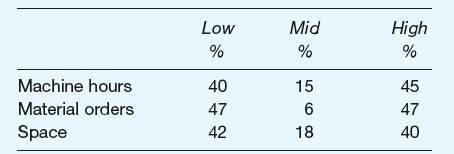A business manufactures refrigerators for domestic use. There are three models: Lo, Mid and Hi. The models,
Question:

The budgeted overheads for the business, for the year, amount to £4,410,000. Direct labour is costed at £8 an hour.
The business is currently facing increasing competition, especially from imported goods. As a result, the selling price of Lo has been reduced to a level that produces a very low profit margin.
To address this problem, an activity-based costing approach has been suggested. The overheads have been analysed and it has been found that these are grouped around main business activities of machining (£2,780,000), logistics (£590,000) and establishment costs (£1,040,000). It is maintained that these costs could be allocated based respectively on cost drivers of machine hours, material orders and space, to reflect the use of resources in each of these areas. After analysis, the following proportionate statistics are available related to the total volume of products:

Required:
(a) Calculate for each product the full cost and selling price determined by:
1 The original (traditional) costing method.
2 The activity-based costing method.
(b) What are the implications of the two systems of costing in the situation given?
(c) What business/strategic options exist for the business in the light of the new information?
Step by Step Answer:

Accounting and Finance An Introduction
ISBN: 978-1292088297
8th edition
Authors: Peter Atrill, Eddie McLaney





